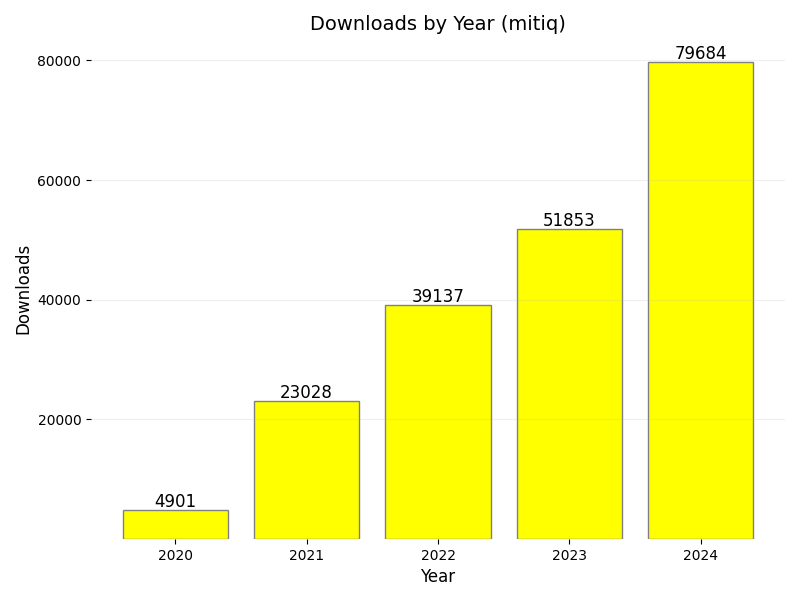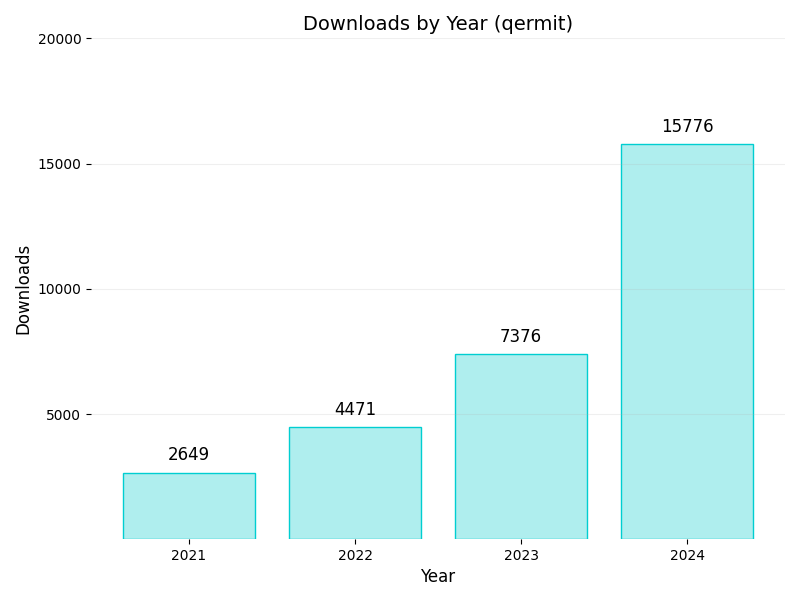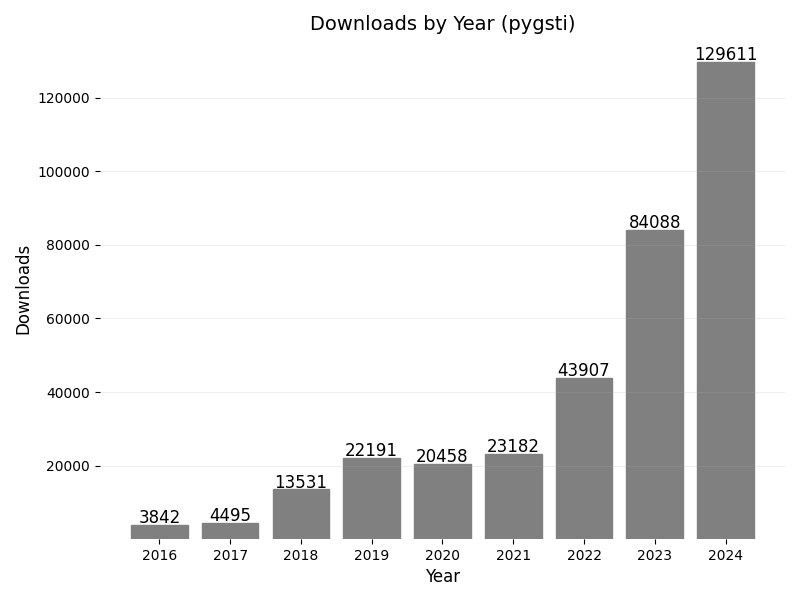On the Impact of Mitiq and its Future
It’s been five years since Mitiq’s journey began—there’s a lot to celebrate, and still so much more to explore.
As we approach the five-year anniversary of the Mitiq project in January 2025, I’d like to reflect on the progress we’ve made and celebrate its ongoing role in shaping the quantum computing ecosystem. Mitiq was created in early 2020 with the intention to make error mitigation easily available to everyone running programs on quantum computers. Have we achieved this goal? Making QEM easily available to everyone is an ambitious target, but as the adoption metrics below demonstrate, Mitiq has significantly lowered the barrier to using Quantum Error Mitigation (QEM) protocols.
As the field of Quantum Error Mitigation has matured, Mitiq has gained recognition as an important component of the quantum computing stack. While some argue that Quantum Error Correction (QEC) could eventually render QEM obsolete, the two techniques can work in tandem. For example, see Unitary Fund’s work demonstrating an approach using Mitiq together with a leading QEC tool, Stim. In a talk at Q2B 2024 John Preskill emphasized that the two approaches will complement one another, even in the long term.
Error mitigation will continue to be useful in the Megaquop era and beyond.
Preskill’s statement underscores the importance of error mitigation and highlight the need for an open-source, platform-agnostic tool like Mitiq to support the growing quantum ecosystem. When Mitiq was first introduced in 2020, the landscape of QEM tools was nascent, with early efforts like pyQuil’s measurement error mitigation and Qiskit Ignis paving the way. Since then, the ecosystem has expanded, with Mitiq leading the charge by implementing nine QEM techniques and offering official support for 6 quantum SDKs (and unofficial support for more).
Let’s take a closer look at how Mitiq has shaped the field and grown over time.
Adoption and Community Growth
At the core of making QEM available to all, is building a platform-agnostic tool. Whether you’re writing your quantum program with Qiskit, Cirq, PyQuil, Qibo, Braket, …, you can use Mitiq! This has been a major driving force behind the growth and adoption of the project, and allows for users to write QEM code once with the flexibility of running on any (gate-based) hardware. As the only SDK-agnostic QEM tool1, Mitiq’s adoption metrics provide a clear measure of its utility and impact.
- Downloads: Over 195,000 total downloads (and counting!).
- GitHub Engagement: Mitiq has accumulated over 360 stars, 160 forks, and contributions from 77 developers worldwide.
- Scientific Reach: Researchers have cited Mitiq over 120 times since 2020 when the whitepaper was put online.

The Quantum Open-Source Software Survey this year indicated that 8.8% of respondents were using Mitiq, with an additional 4.3% planning to use it in the next year. This positions Mitiq as the 10th most used tool in the quantum software space—or 5th if all Qiskit tools are grouped together.
In addition to the tools high adoption, the thriving Mitiq community is a testament to the importance of open-source collaboration. From first-time contributors to experienced quantum researchers, everyone has played a role in elevating Mitiq to the tool it is today.
Driving Research and Innovation
Mitiq has been an instrumental tool in advancing research across diverse areas of quantum computing, including benchmarking, quantum simulation, and QEM research. Its easy-to-use API, combined with extensive documentation, has empowered researchers from fields like condensed matter and many-body physics to explore techniques that push the boundary of what’s possible on today’s quantum hardware. Notable examples include:
- Computational physics: Researchers used Mitiq’s Zero-Noise Extrapolation (ZNE) functionality to mitigate noise in quantum simulations of Heisenberg spin chains, enhancing fidelity and extending simulations beyond hardware coherence times. [Quantum dynamics simulations beyond the coherence time on NISQ hardware by variational Trotter compression]
- Statistical physics: Researchers used Mitiq to demonstrate a reduction in noise during quantum simulations of Bethe eigenstates. To quote the authors (of Algebraic Bethe Circuits):
[Our experiments] highlight the utility of error mitigation. In particular [our experiments] show further evidence that learning based error mitigation is practically useful in reducing the effects of hardware noise.
- Condensed matter: Researchers used Mitiq’s ZNE functionality to mitigate noise in quantum simulations of lattice gauge models, improving the accuracy of observables on noisy hardware. [Towards the real-time evolution of gauge-invariant and quantum link models on NISQ Hardware with error-mitigation]
- QEM research: Researchers used Mitiq to implement and benchmark error mitigation techniques, including Probabilistic Error Cancellation (PEC) and a novel optimization designed for noise-biased qubits. [Low bit-flip rate probabilistic error cancellation]
- Machine learning: Researchers compare ML based approaches for QEM against Mitiq’s ZNE. [Synergy between noisy quantum computers and scalable classical deep learning]
- Benchmarking: Unitary Fund researchers benchmarked Mitiq (ZNE and PEC) across hardware platforms and vendors. Mitiq is currently the only tool available to facilitate such a study. [Testing platform-independent quantum error mitigation on noisy quantum computers]
- Software: The Mitiq team faced a new challenge this year in porting ZNE functionality to Catalyst, an experimental compiler framework based on MLIR developed by Xanadu. Projects like this help us stay at the forefront of both cutting-edge research and advancements in quantum software.
By providing an easy-to-use interface for applying error mitigation techniques, Mitiq has significantly reduced the barrier to both use and study error mitigation protocols.
Education and Outreach
Mitiq has not only advanced research but also contributed to education and training in quantum computing. In January 2024 I had the pleasure to interview more than 50 people across the quantum computing industry to discuss the challenges they faced in using quantum computers. This was part of our homework after receiving an NSF POSE award in order to better understand Mitiq’s positioning in the larger software/hardware ecosystem, and to identify gaps in tooling. One thing that was touched on by nearly all interviewees who had contributed to Mitiq at some point was how easy it was to get started. We pride ourselves on maintaining a well-documented project (even for developer workflows) and offering informal mentorship opportunities. Our industry needs talent, and Mitiq has played a key role in onboarding individuals with essential skills—such as software development, research, and technical writing—into the field. Some of the key ways that we work to encourage this include:
- Documentation: Mitiq has over 100 pages of documentation for our QEM techniques, showing both the theory and practice of applying QEM on real devices. This includes 35 examples to base your next project on as well as a short video explainer of our latest technique.
- Presentations: Since Mitiq’s inception, Unitary Fund staff, alongside Mitiq contributors have delivered over 50 talks to the scientific and programming communities. This year we presented at the APS March meeting, IEEE QCE, and unitaryCON.
- Mitiq workshop: This year we hosted a workshop dedicated solely to teaching people how to use, contribute to, and experiment with Mitiq in conjunction with the QNumerics summer school.
- Project mentorship: We’ve continued to grow our connections with students by mentoring QEM projects through QRISE, the University of Washington’s capstone course, and a new project coming soon in conjuction with the University of Amsterdam.
An encouraging indicator of our success in maintaining an easy-to-contribute-to project is Mitiq’s relatively high ratio of contributors to users. With nearly 200,000 downloads and 77 contributors, Mitiq stands out compared to other projects: QuTiP, for instance, has 167 contributors for 2 million downloads, and Qiskit has 592 contributors for 8.5 million downloads.
Looking Ahead
The space is growing… a lot! It’s hard to get a sense of project usage from open-source software stats, but when many similar projects are seeing upticks in the number of downloads, it is a stronger signal that tools related to error mitigation/suppression/characterization are in high demand. Below you can see the download number from two other open-source projects, Qermit (error mitigation) and pyGSTi (tomography).

Qermit saw a 100% increase in downloads YoY!

pyGSTi amassed over 120k downloads in a calendar year!
Two takeaways from these plots are
- QEM as a whole is growing, not just Mitiq, and
- lots of people are running tomography experiments.
These two facts, taken together with the lack of tooling2 to take noise characterization data to inform QEM showcase a gap in our ecosystem. A gap that we hope to (at least start to) fill in the coming year.
In addition to noise characterization making QEM more practical, we’ve seen two other needs from our community.
- On the software side, tooling is needed for QEM technique comparison and combination, and
- on the research side, the industry needs a better understanding of how QEM will interplay with QEC.
We hope to make progress on both of these in 2025, and we won’t be able to without your help! We need fresh ideas, people writing code, doing research, giving talks, etc. If this sounds like something you’re interested in, I encourage you to get involved.
Join the Mitiq Community
Whether you’re a researcher, educator, or software engineer, or quantum tinkerer, there’s a place for you in the Mitiq community.
- Check out the
mitiqGitHub repository and contribute by opening issues, asking questions, or making a pull request. If you have a QEM technique you’d like to use, let us know! Feature requests are always appreciated, and encouraged. - Join our Discord community to connect with me and all the other wonderful Mitiq developers and quantum enthusiasts.
- Sign up to receive the Mitiq Newsletter to stay up to date with the latest happenings.
Happy holidays and happy new year! Here’s to 2025—a year of fewer errors, and better tools.
Footnotes
-
To create such a tool in the ever-changing quantum software landscape that does not have an established IR, is, to say the least, a lot of work. In particular the maintenance required to stay up to date with SDKs and the conversions between them. ↩
-
Unitary Fund staff, in collaboration with researchers at Yale and Iowa State, put forth a method to use noise characterization data to inform QEM with tooling available here. More recently, IBM recently released the a new API:
NoiseLearner. These are both excellent examples of using noise characterization to inform runtime, with more work to ensure generality and usability across the quantum stack needed. ↩





